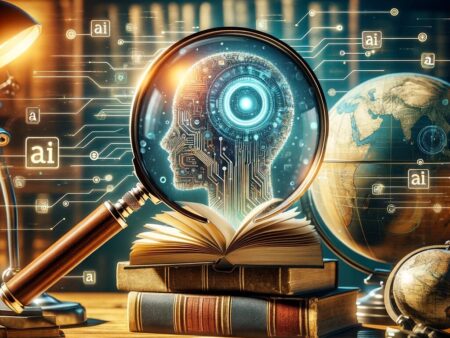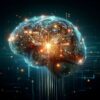Deep learning, a subset of machine learning in the vast ocean of artificial intelligence (AI), represents a significant leap in how machines emulate human decision-making processes. At its core, the deep learning definition revolves around algorithms inspired by the structure and function of the brain, known as artificial neural networks. These networks are designed to recognize patterns, interpret data, and make decisions in a way that mimics human cognition, albeit at a scale and speed that humans cannot match.
Neural networks, the foundation upon which deep learning models are built, consist of layers of interconnected nodes or “neurons,” each layer capable of performing specific tasks. When data is fed into the bottom layer, each subsequent layer processes the data further, refining the interpretation and understanding of the input with every step. This layered architecture enables deep learning models to handle complex, high-dimensional data, making sense of it in a structured and hierarchical fashion.
The importance of deep learning in AI cannot be overstated. It has revolutionized the field, pushing the boundaries of what machines can do. From speech recognition systems that understand and generate human-like speech to sophisticated image recognition software capable of identifying objects with incredible accuracy, deep learning models have become integral to advancing AI technologies. Their ability to learn from large volumes of data without explicit programming for specific tasks makes them incredibly versatile and powerful tools for solving a wide range of problems.
Understanding what deep learning is and how it functions within the broader context of AI provides a foundation for exploring its applications, challenges, and the future direction of this dynamic field. As we delve deeper into the capabilities and potential of deep learning, it’s clear that this technology is not just shaping the future of AI but also redefining what is possible in the digital age.
The Journey of Deep Learning: From Conception to Modern Mastery
The evolution of deep learning is a fascinating journey that spans several decades, marked by theoretical proposals, practical experiments, and significant breakthroughs. This progression from simple concepts of neural networks to today’s sophisticated deep learning models highlights the relentless pursuit of understanding and emulating human intelligence.
The seeds of deep learning were planted in the 1940s and 1950s, with the introduction of the “perceptron” by Frank Rosenblatt. This early model, designed to mimic the thought processes of the human brain, laid the groundwork for neural networks. However, it was limited in its capabilities, able to solve only simple problems due to the technological and theoretical constraints of the time.
A significant milestone in the development of deep learning technology came in the 1980s, with the introduction of the backpropagation algorithm by Geoffrey Hinton and others. This algorithm enabled neural networks to adjust their internal parameters in a way that minimizes the difference between the actual output and the desired output, significantly improving their learning capability. This period also saw the rise of the concept of “deep” neural networks, which contain multiple hidden layers between the input and output, allowing for the extraction of more complex features and patterns from data.
The 1990s and early 2000s witnessed the ebb and flow of interest in neural networks, often referred to as the “AI winter,” due to challenges in training deep networks and a lack of computational resources. However, the landscape began to change with the advent of more powerful computers and the availability of large datasets, setting the stage for a renaissance in neural network research.
A pivotal moment came in 2012 when a deep neural network called AlexNet, designed by Alex Krizhevsky, Ilya Sutskever, and Geoffrey Hinton, won the ImageNet Large Scale Visual Recognition Challenge by a substantial margin. This victory demonstrated the superior capability of deep learning models in handling complex visual recognition tasks, reigniting interest and investment in the field.
Since then, the development of deep learning has accelerated, with models becoming increasingly sophisticated. Innovations such as Generative Adversarial Networks (GANs) by Ian Goodfellow and colleagues, and advancements in natural language processing with models like BERT and GPT by researchers at Google and OpenAI, respectively, have further showcased the versatility and power of deep learning.
Today, deep learning stands as a cornerstone of AI, driving progress in diverse fields from healthcare to autonomous vehicles. Its evolution is a testament to the ingenuity and perseverance of researchers who have pushed the boundaries of technology to mimic the intricate workings of the human mind.
Unraveling the Mechanics of Deep Learning
Deep learning, a subset of AI deep learning, harnesses the computational architecture of neural networks to model and understand complex patterns in data. The fundamental building block of these networks is the neuron, a simplified digital version of the human brain’s neurons. In the context of deep machine learning, neurons are arranged in layers that perform various levels of abstraction and pattern recognition.
Neural Networks: The Core of Deep Learning
Neural networks consist of an input layer, one or more hidden layers, and an output layer. Each neuron in these layers is connected to multiple neurons in the next layer, forming a dense network through which data flows and is processed. The “deep” in deep learning refers to the presence of multiple hidden layers that allow the model to learn complex features at various levels of abstraction.
Activation functions play a crucial role in this process. They determine whether a neuron should be activated or not, based on the weighted sum of its inputs. These functions introduce non-linearity into the model, enabling it to learn and model complex relationships in the data. Common activation functions include ReLU (Rectified Linear Unit), Sigmoid, and Tanh, each with its own characteristics and areas of application.
Deep Learning Architectures
Deep learning boasts a variety of architectures designed for specific types of data and tasks:
- Convolutional Neural Networks (CNNs) are specialized for processing structured grid data such as images. CNNs utilize convolutional layers to efficiently handle the high dimensionality of visual data, extracting features like edges and textures in early layers and more complex patterns in deeper layers. This makes them ideal for image recognition and classification tasks.
- Recurrent Neural Networks (RNNs) are designed for sequential data, such as time series or natural language. RNNs have the unique feature of feeding information from previous steps back into the network, allowing them to maintain a form of memory. This characteristic is crucial for tasks where context and order matter, such as language translation or speech recognition.
The Importance of Big Data and Computational Power
The deep learning meaning extends beyond the architecture and algorithms, touching on the critical role of big data and computational power. Deep learning models require vast amounts of data to learn effectively, as the variety and volume of data help the model to generalize well to new, unseen data. Big data provides the raw material from which these models can learn nuanced patterns and relationships.
Moreover, the training of deep learning models is computationally intensive, often requiring specialized hardware such as GPUs (Graphics Processing Units) or TPUs (Tensor Processing Units). These technologies significantly accelerate the training process, allowing for the development of more complex and accurate models. The advancements in computational power, alongside the explosion of available data, have been pivotal in enabling the rapid progress and adoption of deep learning across various domains.
In summary, the workings of deep learning—a pivotal component of what is deep learning AI—rely on the intricate interplay between neural network architectures, activation functions, and the computational strategies that handle layers of neurons. Coupled with the ever-growing availability of big data and advances in computational power, deep learning continues to push the boundaries of what machines can learn and achieve, marking a significant milestone in the journey of artificial intelligence.
Transforming Industries: The Versatile Applications of Deep Learning
Deep learning, a sophisticated branch of artificial intelligence, has been instrumental in driving innovations across a wide spectrum of industries. Its ability to learn from large datasets and identify patterns makes it exceptionally versatile. Here’s a look at how deep learning is revolutionizing various fields through its key applications.
Image and Speech Recognition
One of the most prominent applications of deep learning is in image and speech recognition technologies. Convolutional Neural Networks (CNNs), a specific type of deep learning model, have dramatically improved the accuracy of image classification, object detection, and even medical imaging analysis, enabling advancements in automated diagnostics and surveillance systems. Similarly, speech recognition has benefited from deep learning, enhancing voice-activated assistants, transcription services, and real-time translation systems. These technologies have not only made human-machine interactions more intuitive but have also paved the way for creating more accessible digital environments.
Natural Language Processing (NLP)
Deep learning has significantly advanced the field of Natural Language Processing (NLP), enabling machines to understand, interpret, and generate human language with remarkable accuracy. This progress is evident in chatbots, sentiment analysis, and automated content creation tools. By processing and analyzing vast amounts of text data, deep learning models can grasp contextual nuances, making them invaluable for customer service automation, market research, and even in literary analysis.
Autonomous Vehicles
The dream of fully autonomous vehicles is inching closer to reality, largely thanks to deep learning. By processing data from various sensors and cameras in real-time, deep learning models enable vehicles to make split-second decisions, recognize traffic patterns, and understand complex road environments. This technology not only promises to revolutionize transportation but also holds the potential to significantly reduce accidents caused by human error.
Healthcare
In healthcare, deep learning is making waves by improving diagnostic accuracy and personalizing patient care. From analyzing X-rays and MRI scans for signs of diseases to predicting patient outcomes based on historical data, deep learning models are assisting medical professionals in making more informed decisions. Furthermore, its application in drug discovery and genomics is accelerating the development of new treatments and therapies.
Finance
The finance industry benefits from deep learning in areas like fraud detection, algorithmic trading, and customer service automation. By analyzing patterns within vast datasets, deep learning models can identify anomalous transactions that may indicate fraud, while also optimizing trading strategies to capitalize on market trends.
Future Applications
Looking ahead, the potential applications of deep learning seem boundless. In environmental science, deep learning could play a crucial role in climate modeling and conservation efforts by analyzing complex environmental data. In the realm of entertainment, it could revolutionize content creation through generative models, creating realistic CGI characters or generating new music and art.
The impact of deep learning across these fields has been profound, not only in enhancing existing technologies but also in creating new possibilities that were once the realm of science fiction. As deep learning technology continues to evolve, its applications are set to further transform industries, making processes more efficient, enhancing creativity, and improving the quality of life. The future applications of deep learning, powered by ever-increasing data and computational capabilities, promise to usher in a new era of innovation and discovery.
Navigating the Terrain: Challenges and Prospects in Deep Learning
As deep learning continues to shape the future of technology and innovation, it faces a constellation of challenges that must be addressed to unlock its full potential. These hurdles not only pose technical obstacles but also raise important ethical considerations. Concurrently, the relentless pace of advancement in deep learning foreshadows a future brimming with unprecedented possibilities.
Addressing the Challenges
Data Biases: One of the most pressing issues in deep learning is the prevalence of data biases. Since deep learning models learn from existing datasets, any inherent biases in the data can lead to skewed or unfair outcomes. This is particularly concerning in applications related to social justice, law enforcement, and hiring practices, where biased algorithms could perpetuate or even exacerbate societal inequalities.
Ethical Considerations: As deep learning systems become more integrated into daily life, ethical considerations become increasingly critical. Issues such as privacy, surveillance, and the autonomy of decision-making are at the forefront of discussions about the responsible use of deep learning. There’s a growing call for ethical frameworks and regulatory guidelines to ensure that advancements in AI benefit humanity without infringing on individual rights or freedoms.
Computational Resources: The computational intensity of training deep learning models is another significant challenge. Advanced models require vast amounts of processing power, which can be cost-prohibitive and environmentally unsustainable. This necessitates ongoing efforts to optimize algorithms for efficiency and to develop more sustainable computing infrastructures.
Future Directions
Despite these challenges, the future of deep learning is bright, with several emerging trends and potential breakthroughs on the horizon.
Efficient and Sustainable AI: There is an increasing focus on creating more efficient AI models that require less computational power, addressing both the cost and environmental impact of training deep learning models. Innovations in algorithm design and hardware are making it possible to run sophisticated AI applications on smaller devices, reducing the reliance on large data centers.
Federated Learning and Privacy Preservation: Federated learning emerges as a promising approach to training deep learning models on decentralized data, enhancing privacy and security. By allowing models to learn from data without ever centralizing it, federated learning offers a way to leverage the power of AI while respecting user privacy.
Explainable AI (XAI): As AI systems become more complex, the need for transparency and understandability grows. Explainable AI aims to make the decision-making processes of AI systems more transparent, enabling humans to understand, trust, and effectively manage AI technologies.
General AI and Transfer Learning: The pursuit of General AI, systems that can understand, learn, and apply knowledge in a wide variety of tasks, continues. Progress in transfer learning, where a model trained on one task is adapted for another, is a step toward this goal, promising to reduce the need for large, task-specific datasets and to accelerate the development of versatile AI applications.
Cross-disciplinary Innovations: The future of deep learning also lies in its intersection with other fields. From quantum computing potentially supercharging AI’s computational capabilities to neuroscience inspiring more effective neural network architectures, these cross-disciplinary innovations are set to propel deep learning into new realms of possibility.
In conclusion, while deep learning faces significant challenges, its trajectory points towards a future rich with innovation and transformative potential. By addressing ethical and technical challenges head-on, the field is poised to continue its profound impact on society, pushing the boundaries of what’s possible with AI.
Table of Contents
Toggle


